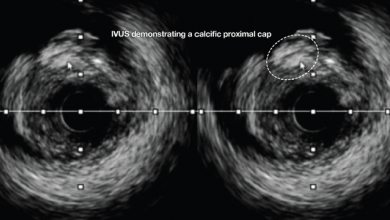Search results
Author(s):
Calum Creaney
,
Simon J Walsh
Added:
3 years ago
There has been rapid development in the techniques used for chronic total occlusion (CTO) percutaneous coronary intervention (PCI) over the past decade, with success rates in experienced centres now exceeding 90%.1 This is in part due to advances in devices and techniques for CTO crossing, but also an improved understanding of strategy. The development of the ‘hybrid algorithm’ has improved…
View more
Author(s):
Claudia Cosgrove
,
Kalaivani Mahadevan
,
James Spratt
,
et al
Added:
2 years ago
Author(s):
Vijay S Ramanath
,
Craig Thompson
Added:
3 years ago
Coronary chronic total occlusions (CTOs) remain one of the most challenging percutaneous challenges in interventional cardiology, with technical success rates of only ~50–70 %.1,2 This lesion subset often poses the greatest risk and often requires techniques and equipment not typically utilised for more acute coronary lesions. However, successful percutaneous CTO revascularisation is associated…
View more
Author(s):
Nicolaus Reifart
Added:
3 years ago
Definition and Prevalence
Nowadays it is widely accepted to define chronic total occlusions (CTOs) of the coronary artery as lesions with thrombolysis in myocardial infarction 0 flow for more than three months (either angiographically proven or with high clinical likelihood).1 Occlusions of less than four weeks following an acute infarction are defined as acute or subacute and occlusions of…
View more
Author(s):
Mohammed Shamim Rahman
,
Ruben de Winter
,
Alex Nap
,
et al
Added:
2 years ago
Author(s):
Alfredo Galassi
,
Aaron Grantham
,
David Kandzari
,
et al
Added:
3 years ago
Section A
Techniques for Chronic Total Occlusions Revascularisation
Access Route, Guiding Catheter Selection and Contralateral Injection
The femoral approach is the preferred access route by most operators. However, the radial approach might be chosen because of severe peripheral vascular disease, operator’s preference or for contralateral injection. The guiding principle of access selection is…
View more
Author(s):
Inga Narbute
,
Sanda Jegere
,
Indulis Kumsars
,
et al
Added:
3 years ago
Coronary bifurcation disease is present in up to 15–20 % of lesions undergoing percutaneous coronary intervention (PCI) and remains one of the outstanding challenges of treatment with PCI.1,2 PCI for coronary bifurcations is associated with more procedural complications and higher restenosis and adverse event rates than lesions in the body of the vessel.3–7 The introduction of drug-eluting stents…
View more
Author(s):
Inga Narbute
,
Sanda Jegere
,
Indulis Kumsars
,
et al
Added:
3 years ago
Abstract
Together with calcified lesions, saphenous vein grafts, chronic total occlusions and unprotected left main lesions, bifurcation lesions are complex lesions that remain among the outstanding challenges of treatment with percutaneous coronary intervention. Bifurcation lesions are associated with increased rates of procedural complications, restenosis and adverse events than lesions in the…
View more
Author(s):
Kalaivani Mahadevan
,
Claudia Cosgrove
,
Julian Strange
Added:
2 years ago
Author(s):
Tanush Gupta
,
Michael Weinreich
,
Mark Greenberg
,
et al
Added:
3 years ago
Percutaneous coronary intervention (PCI) is the most commonly used revascularisation modality for obstructive coronary artery disease.1 Despite significant advances in PCI over the past 40 years, severe coronary calcification remains a challenge for successful PCI.2,3 Up to 20% of patients undergoing PCI are estimated to have moderate to severe coronary calcification.4,5
Heavily calcified…
View more














